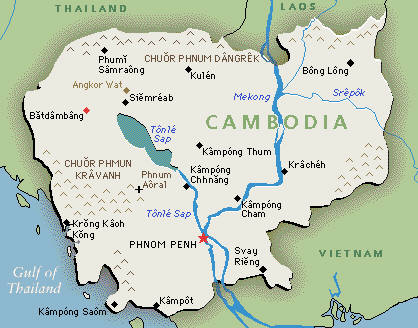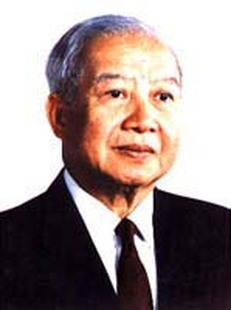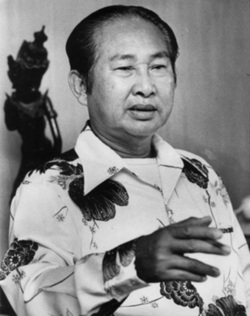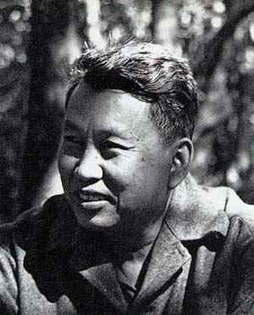"We were timid and lost. We had to be silent. We not only lost our identities, but we lost our pride, our senses, our religion, our loved ones, our souls, ourselves."
-TEEDA BUTT MAM from Children of Cambodia's Killing Fields: Memoirs by Surv
Key Players
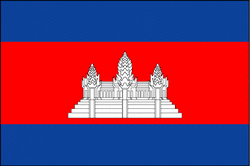
Khmer Rogue: "Radical communist movement that ruled Cambodia from 1975 to 1979 after winning power through a guerrilla war. It was purportedly set up in 1967 as the armed wing of the Communist Party of Kampuchea."
Prince Sihanouk: "The King of Cambodia from 1941 to 1955 and again from 1993 until 2004. He was the effective ruler of Cambodia from 1953 until 1970."
Viet Cong: "Guerilla force that, with the support of the North Vietnamese Army, fought against South Vietnam (late 1950s–1975) and the United States (early 1960s–1973)."
Lon Nol: "Soldier and politician whose overthrow of Prince Norodom Sihanouk (1970) involved Cambodia in the
Indochina war and ended in the takeover (1975) of the country by the communist Khmer Rouge."
Pol Pot: " Khmer political leader whose totalitarian regime (1975–79) imposed severe hardships on the Cambodian
people. His radical communist government forced the mass evacuations of cities, killed or displaced millions of
people, and left a legacy of brutality and impoverishment."
Prince Sihanouk: "The King of Cambodia from 1941 to 1955 and again from 1993 until 2004. He was the effective ruler of Cambodia from 1953 until 1970."
Viet Cong: "Guerilla force that, with the support of the North Vietnamese Army, fought against South Vietnam (late 1950s–1975) and the United States (early 1960s–1973)."
Lon Nol: "Soldier and politician whose overthrow of Prince Norodom Sihanouk (1970) involved Cambodia in the
Indochina war and ended in the takeover (1975) of the country by the communist Khmer Rouge."
Pol Pot: " Khmer political leader whose totalitarian regime (1975–79) imposed severe hardships on the Cambodian
people. His radical communist government forced the mass evacuations of cities, killed or displaced millions of
people, and left a legacy of brutality and impoverishment."
Prince Sihanouk Lon Nol Pol Pot
Before the Conflict
Prior to 1953, the small Asian country of Cambodia was occupied by the French, along with its neighbor, Vietnam. Previously, it was part of ancient Khmer. Prince Sihanouk was the monarchical ruler of the country, and he managed to help the country maintain a neutral position when it came to the conflict in Vietnam after they, too, gained their independence from France.
In order to understand the eventual atrocities that occur in Cambodia, it is important to establish familiarity with the conflicts of the Vietnamese once the country was divided into two separate nations. With this split came irrevocable conflict. North Korea was controlled by Communist forces while South Korea remained democratic. Such stark political differences sparked an immediate war. A group of North Korean Communists known as the Viet Cong infiltrated South Korea in order to attack the South Korean army from within. The United States attempted to intervene in the conflict, but to no avail.
Prince Sihanouk was ousted by military forces in 1970. Lon Nol then became president of the new Khmer Republic. A group known as the Khmer Rouge joined forces behind the recently deposed Prince Sihanouk and civil war erupted within Cambodia's own borders. Prior to this development, Sihanouk had allowed North Koreans to utilize Cambodian ports. Because of this, the United States bombed alleged Viet Cong clusters within Cambodia. This led to the death of over 700,000 Cambodians by the United States alone, not factoring in casualties from the Cambodian civil conflict.
The Khmer Rouge, led by French educated Pol Pot, initially started out as a small band of rebels, but it grew thanks to Lon Nol's association with America and the growing distrust of the west. They also enjoyed support from China and North Korea. This made Lon Nol's job of establishing national stability that much harder, because in addition to fighting off Vietnamese communists, he also had to try and ward off the internal Khmer Rouge.
Finally, in 1975, the South Korean capital of Saigon was taken over by North Korea. In that same year, the Khmer Rouge overthrew Lon Nol. The civilian death total from the Cambodian civil war alone is estimated to be around 156,000 men, women and children. It is important to note that at least half of that number were civilians.
In order to understand the eventual atrocities that occur in Cambodia, it is important to establish familiarity with the conflicts of the Vietnamese once the country was divided into two separate nations. With this split came irrevocable conflict. North Korea was controlled by Communist forces while South Korea remained democratic. Such stark political differences sparked an immediate war. A group of North Korean Communists known as the Viet Cong infiltrated South Korea in order to attack the South Korean army from within. The United States attempted to intervene in the conflict, but to no avail.
Prince Sihanouk was ousted by military forces in 1970. Lon Nol then became president of the new Khmer Republic. A group known as the Khmer Rouge joined forces behind the recently deposed Prince Sihanouk and civil war erupted within Cambodia's own borders. Prior to this development, Sihanouk had allowed North Koreans to utilize Cambodian ports. Because of this, the United States bombed alleged Viet Cong clusters within Cambodia. This led to the death of over 700,000 Cambodians by the United States alone, not factoring in casualties from the Cambodian civil conflict.
The Khmer Rouge, led by French educated Pol Pot, initially started out as a small band of rebels, but it grew thanks to Lon Nol's association with America and the growing distrust of the west. They also enjoyed support from China and North Korea. This made Lon Nol's job of establishing national stability that much harder, because in addition to fighting off Vietnamese communists, he also had to try and ward off the internal Khmer Rouge.
Finally, in 1975, the South Korean capital of Saigon was taken over by North Korea. In that same year, the Khmer Rouge overthrew Lon Nol. The civilian death total from the Cambodian civil war alone is estimated to be around 156,000 men, women and children. It is important to note that at least half of that number were civilians.
What led to the Conflict?
In 1970, the United States invaded Cambodia to expel the North Vietnamese, but this instead drove them deeper into the country. This allowed the Vietnamese to find allies in the Khmer Rouge. With the added strength of the Vietnamese, Pol Pot and the Khmer Rouge managed to take control of Cambodia by over-taking the city of Phnom Penh. Lon Nol is overthrown and Sihanouk was briefly named head of state. The country was then re-named Kampuchea.
All residents of the city were forced to move to the countryside to become agricultural workers. Pol Pot, leader of the Khmer Rouge, used the Maoist-Communist model to base his own model for a perfect Communist Cambodia. The Khmer Rouge declared 1975 as "Year Zero" and began to shape their society.
All residents of the city were forced to move to the countryside to become agricultural workers. Pol Pot, leader of the Khmer Rouge, used the Maoist-Communist model to base his own model for a perfect Communist Cambodia. The Khmer Rouge declared 1975 as "Year Zero" and began to shape their society.
Life During the Conflict
Disliking the capitalist western ideologies, they persecuted doctors, lawyers, police, or current/former military men. People were also targeted with their affiliations with Christianity, Buddhism, or Hindu. Muslims were forced to eat meat and those who refused were murdered. The motto of the regime stated, “What is rotten must be removed”, and many were shot or bludgeoned if they served as a reminder or the west or “old society”. As well as positions in society and religions, the Khmer Rouge also threatened the three largest minorities: the Vietnamese, Chinese, and Cham Muslims, along with a few other smaller groups. About half of the Chinese living in Cambodia in 1975 perished due to the regime.
The regime of Khmer Rouge placed people in communal living environments in an effort to create a society that lacked competition. All citizens would participate in rural work projects and all western innovations were removed.
People were ranked in society in the order that they were loyal to the Khmer Rouge. Most people never ranked up in the order and were murdered in the killing fields around the communes or the prison camp Tuol Sleng Centre. In the Tuol Sleng Centre, a school that had been turned into a prison, many people were tortured and killed for giving false confessions.
Through forced physical labor, starvation, and torture, in only four years the Khmer Rouge eliminated over 1.7 million people (roughly 25 percent of the population). Because importance in society was ranked on ability to work and serve, handicapped, elderly, and children suffered extreme casualties.
While in power, Pol Pot began an experiment to purify his society in creating an “agrarian utopia” inspired by Mao Zedong’s Revolution in Communist China. Because of this ideology: all foreigners were expelled, embassies closed, all medical and foreign economic assistance is refused. All media outputs (such as newspapers and television stations) are shut down, mail and telephone usage monitored, foreign language use is banned, radios and bicycles are confiscated. All businesses are shut down and money was forbidden.Religion is banned, educated stopped, health care removed, and any authority of parents over their kids is removed. Cambodia is effectively separated from the outside world and any influences of western ideals.
The conditions of life were extreme – workdays often lasted from 4 A.M. until 10 P.M. with very little rest. Many workers often worked ten days straight with only one day off and were not allowed to eat any of the crops they harvested, despite their malnourished figures. Many people were killed for even the smallest infraction, and people often died in the fields from overwork and starvation.
People were forbidden to gather in groups of more than two people. Also, children were taken from parents and forced into arranged marriages in collective ceremonies that often involved hundreds of unwilling couples.
The regime of Khmer Rouge placed people in communal living environments in an effort to create a society that lacked competition. All citizens would participate in rural work projects and all western innovations were removed.
People were ranked in society in the order that they were loyal to the Khmer Rouge. Most people never ranked up in the order and were murdered in the killing fields around the communes or the prison camp Tuol Sleng Centre. In the Tuol Sleng Centre, a school that had been turned into a prison, many people were tortured and killed for giving false confessions.
Through forced physical labor, starvation, and torture, in only four years the Khmer Rouge eliminated over 1.7 million people (roughly 25 percent of the population). Because importance in society was ranked on ability to work and serve, handicapped, elderly, and children suffered extreme casualties.
While in power, Pol Pot began an experiment to purify his society in creating an “agrarian utopia” inspired by Mao Zedong’s Revolution in Communist China. Because of this ideology: all foreigners were expelled, embassies closed, all medical and foreign economic assistance is refused. All media outputs (such as newspapers and television stations) are shut down, mail and telephone usage monitored, foreign language use is banned, radios and bicycles are confiscated. All businesses are shut down and money was forbidden.Religion is banned, educated stopped, health care removed, and any authority of parents over their kids is removed. Cambodia is effectively separated from the outside world and any influences of western ideals.
The conditions of life were extreme – workdays often lasted from 4 A.M. until 10 P.M. with very little rest. Many workers often worked ten days straight with only one day off and were not allowed to eat any of the crops they harvested, despite their malnourished figures. Many people were killed for even the smallest infraction, and people often died in the fields from overwork and starvation.
People were forbidden to gather in groups of more than two people. Also, children were taken from parents and forced into arranged marriages in collective ceremonies that often involved hundreds of unwilling couples.
Post Genocide
After the 11 year conflict between Cambodia and the occupying Vietnamese, the United States imposed economic sanctions on Cambodia that helped drive the Vietnamese out of the country. This process was made slightly easier once Vietnam lost the support and financial backing of the Communist Soviet Union. The last Vietnamese troops retreated from Cambodia in 1989.
With this retreat, Buddhism was officially reinstated as the official religion of the country and Prince Sihanouk was elected as leader of Cambodia in the country's first democratic election since the conflict. Cambodians were able to own land once again and the development of a free, democratic society continued.
The Khmer Rouge, unhappy with this new democratic approach to Cambodian government, attempted to raise resistance, but were unsuccessful. Many aligned themselves with the new government in an attempt to save themselves from harsh repercussion due to their association with the Khmer Rouge. Those who were questioned and tried tended to place the blame on those who were dead or otherwise could not defend themselves. Much of the blame fell on Pol Pot himself.
In 1995, the mass genocide that took place in Cambodia was brought to the forefront of everyone's minds when mass graves were discovered. Much of the human remains found among the "killing fields" have been cleaned and preserved in an effort to pay homage to the lives lost during this violent time in Cambodia's history.
With this retreat, Buddhism was officially reinstated as the official religion of the country and Prince Sihanouk was elected as leader of Cambodia in the country's first democratic election since the conflict. Cambodians were able to own land once again and the development of a free, democratic society continued.
The Khmer Rouge, unhappy with this new democratic approach to Cambodian government, attempted to raise resistance, but were unsuccessful. Many aligned themselves with the new government in an attempt to save themselves from harsh repercussion due to their association with the Khmer Rouge. Those who were questioned and tried tended to place the blame on those who were dead or otherwise could not defend themselves. Much of the blame fell on Pol Pot himself.
In 1995, the mass genocide that took place in Cambodia was brought to the forefront of everyone's minds when mass graves were discovered. Much of the human remains found among the "killing fields" have been cleaned and preserved in an effort to pay homage to the lives lost during this violent time in Cambodia's history.
The Current State of Affairs
In 1993 Norodom Sihanouk was reinstated as King of Cambodia, but Cambodia was now under a democratic government due to the UNTAC (United Nations Transitional Authority in Cambodia) sponsored elections. In 1997 co-Prime Minister Hun Sen, a former commander of the Khmer Rouge, and his forces led a coup against the non-communist politicians in the government. Many of these were killed by Hun Sen’s forces. Through political oppression and reconstruction efforts Cambodians government has experienced some stability. In July of 2010 Kang Kek Iew, a former commandant of the extermination camp S21, was tried and sentenced to life in prison. He was the first Khmer Rouge member to be convicted. Hun Sen has been reluctant to pursue prosecution of other member of the Khmer claiming that it would upset the political stability of the country. It is more likely to be because there is still a heavy presence of Khmer Rouge in local and national positions of government.
Timeline of Events
1863.
Cambodia becomes a protectorate of France. French colonial rule lasts 90 years.
1941.
Prince Norodom Sihanouk becomes king. Cambodia is occupied by Japan during WWII.
1945.
Japanese occupation ends.
1946.
France re-imposes protectorate; with a new constitution, Cambodia is allowed to form political parties. Communist guerillas thus begin a violent campaign against the French.
1953 – 1960.
Cambodia wins independence from France and King Sihanouk pursues a political career. He becomes Prime Minister and eventually Head of State.
1965.
Regulations with the United States are ended by King Sihanouk; he instead allows guerrillas of the North Vietnamese to establish bases in Cambodia to pursue their campaign versus the U.S. supported government in South Vietnam.
1969.
The United States begins a secret bombing campaign against North Vietnamese forces on Cambodian soil.
1970.
Sihanouk is overthrown by Prime Minister Lon Nol in a coup. Over the next few years the Cambodian army loses territory against the North Vietnamese and communist Khmer Rouge guerrillas.
1975.
Lon Nol is overthrown as Pol Pot and the Khmer Rouge occupy Phnom Penh. Sihanouk becomes head of state (briefly), and the country is re-named as Kampuchea.
All residents of the city are forced to move to the countryside to become agricultural workers. Basic freedoms are removed, money is worthless and religion is banned. This is the year the Khmer Rouge refer to as “Year Zero”.
Hundreds of thousands are tortured and executed in special centers. Many starve, or die from exhaustion or disease. The total death toll during the next three years is estimated to be at least 1.7 million.
1976.
The country is re-named Democrative Kampuchea, to mark the beginning of a new era. The name is the old form of the contemporary form Cambodia. Sihanouk resigns; Pol Pot is named prime minister. Khieu Samphan is named head of state.
1977.
The Cambodian-Vietnamese War begins.
1978.
Cambodia is invaded by Vietnam.
1979.
The Vietnamese take the city of Phnom Penh. Pol Pot and Khmer Rouge forces flee to the border region with Thailand. The People’s Republic of Kampuchea is established. The Khmer Rouge Rule is over.
1981.
The pro-Vietnamese Kampuchean People’s Revolutionary Party wins the elections to the National Assembly. The international community refuses to recognize the new government. The government, which includes Khmer Rouge and Sihanouk, retains its seat at the United Nations.
1985.
Hun Sen is named Prime Minister. Guerrilla warfare plagues Cambodia and hundreds of thousands become refugees.
1989.
Vietnamese troops withdraw. Hun Sen tries to attack foreign investment by abandoning socialism. The country is re-named the State of Cambodia. Buddhism is re-established as the state religion.
1991.
A peace agreement is signed in Paris. Sihanouk becomes head of state.
1993.
General elections see the royalist Funcinpec party win the most seats followed by Hun Sen’s Cambodian People’s Party. A three-party coalition is formed with
Funcinpec’s Prince Norodom Ranariddh as Prime Minister and Hun Sen as deputy Prime Minister. The monarchy is restored. Sihanouk is named King again. The
country is re-named the Kingdom of Cambodia. The government-in-exhile loses its seat at the United Nations.
1994.
Thousands of Khmer Rouge guerrillas surrender in government amnesty.
1995.
Mass graves are uncovered.
1996.
Deputy leader of Khmer Rouge Leng Sary forms a new party and is granted amnesty by Sihanouk.
1997.
Hun Sen forms a coup against the Prime Minister, Prince Ranariddh, and replaces him with Ung Huot. The coup attracts international condemnation. The Khmer Rouge put Pol Pot on trial and sentences him to life in prison.
1998.
Prince Ranariddh is tried and found guilty to arms smuggling, but is then pardoned. Pol Pot dies in his jungle hideout. Elections in July are won by Hun Sen’s CPP, amid allegations of harassment. A coalition is formed between the CPP and Funcinpec. Hun Sen becomes Prime Minister; Ranariddh is president of the National Assembly.
2001.
A law is passed setting up a tribunal to bring genocide charges against the leaders of the Khmer Rouge. International donors pledge $560 million in aid. United States based Cambodian Freedom Fighters members convicted of 2000 attack in Phnom Penh. First bridge across the Mekong River opens, linking east and west Cambodia.
2002.
First multi-party local elections; ruling Cambodian People’s Party wins in all but 23 out of 1,620 communes. Ranariddh’s half-brother Prince Norodom Chakrapong sets up his own Norodom Chakrapong Khmer Soul Party.
2003.
Hun Sen’s Cambodia People’s Party wins the general elections but fails to secure sufficient majority to govern alone.
2004.
Prime Minister Hun Sen is re-elected after CPP makes a deal with the royalist Funcinpec party. King Sihanouk abdicates and is succeeded by his son Norodom Sihamoni.
2005.
Opposition leader Sam Rainsy goes abroad after parliament strips him of immunity from prosecution, leaving him open to defamation charges brought by the ruling coalition. Tribunal to try Khmer Rouge leaders gets “OK” from United Nations after years of funding debates. Rainsy is convicted in absentia of defaming Hun Sen and is sentenced to nine months in prison.
2006.
Rainsy receives a royal pardon and returns home. Ta Mok, one of the top leaders of the Khmer Rouge regime, dies at the age of 80. Funcinpec party drops Prince Norodom Ranariddh as its leader.
2007.
Ranariddh is sentenced in absentia to 18 months in prison for selling the Funcinpec party’s headquarters. United Nations tribunals begin questioning Khmer Rouge suspects about allegations of genocide. The senior surviving Khmer Rouge member, Nuon Chea (“Brother Number Two”) is arrested and charged with crimes against humanity.
2008.
US court convicts CFF leader Chhun Yasith of masterminding 2000 attack in Phnom Penh. Hun Sen's ruling CPP claims victory in parliamentary elections criticized by EU monitors. Cambodia and Thailand move troops to disputed land near Preah Vihear temple after decision to list it as UN World Heritage Site fans nationalist sentiment on both sides. Two Cambodian soldiers die in an exchange of fire with Thai troops in the disputed area.
2009.
Former Khmer Rouge leader Kaing Guek Eav known as Duch goes on trial on charges of presiding over the murder and torture of thousands of people as head o the notorious Tuol Sleng prison camp. Parliament again strips opposition leader Sam Rainsy of immunity. He is charged but fails to appear in court. Another row with Thailand, after Cambodia refuses to extradite ex-Thai Prime Minister Thaksin Shinawatra and appoints him as an economic adviser instead.
2010.
Comrade Duch is found guilty of crimes against humanity and given 35-year prison sentence. Diplomatic ties with Thailand resumed after Cambodian government announces resignation of Thaksin Shinawatra. Exiled opposition leader Sam Rainsy is sentenced in absentia to 10 years in jail after being found guilty of manipulating a map to suggest Cambodia is losing land to Vietnam.
2011.
Tensions rise as Cambodia charges two Thai citizens with spying after they were arrested for crossing the disputed border. Respective forces exchange fire across the border. Hun Sen calls for UN peacekeepers. Three most senior surviving Khmer Rouge members, including leader Pol Pot's right-hand man, "Brother Number Two" Nuon Chea, go on trial on charges of genocide and crimes against humanity. Cambodia and Thailand agree to withdraw troops from disputed area.
2012.
February - Duch loses appeal against conviction at UN-backed tribunal and has sentence increased to life.
2012.
March - A second judge quits the tribunal. Swiss Judge Laurent Kasper-Ansermet says going because his Cambodian counterpart, You Bunleng, had thwarted attempts to investigate some former members of the Khmer Rouge regime.
2012.
April - Outspoken environmental activist killed in confrontation with police. Chut Wutty was shot while travelling in a threatened forest region in the south-west.
2012.
May - Government suspends the granting of land for development by private companies in a bid to curb evictions and illegal logging.
2012.
July - Cambodia and Thailand withdraw their troops from a disputed border area near the Preah Vihear temple in line with a ruling by the International Court of Justice which aims to halt outbreaks of armed conflict in recent years.
Cambodia becomes a protectorate of France. French colonial rule lasts 90 years.
1941.
Prince Norodom Sihanouk becomes king. Cambodia is occupied by Japan during WWII.
1945.
Japanese occupation ends.
1946.
France re-imposes protectorate; with a new constitution, Cambodia is allowed to form political parties. Communist guerillas thus begin a violent campaign against the French.
1953 – 1960.
Cambodia wins independence from France and King Sihanouk pursues a political career. He becomes Prime Minister and eventually Head of State.
1965.
Regulations with the United States are ended by King Sihanouk; he instead allows guerrillas of the North Vietnamese to establish bases in Cambodia to pursue their campaign versus the U.S. supported government in South Vietnam.
1969.
The United States begins a secret bombing campaign against North Vietnamese forces on Cambodian soil.
1970.
Sihanouk is overthrown by Prime Minister Lon Nol in a coup. Over the next few years the Cambodian army loses territory against the North Vietnamese and communist Khmer Rouge guerrillas.
1975.
Lon Nol is overthrown as Pol Pot and the Khmer Rouge occupy Phnom Penh. Sihanouk becomes head of state (briefly), and the country is re-named as Kampuchea.
All residents of the city are forced to move to the countryside to become agricultural workers. Basic freedoms are removed, money is worthless and religion is banned. This is the year the Khmer Rouge refer to as “Year Zero”.
Hundreds of thousands are tortured and executed in special centers. Many starve, or die from exhaustion or disease. The total death toll during the next three years is estimated to be at least 1.7 million.
1976.
The country is re-named Democrative Kampuchea, to mark the beginning of a new era. The name is the old form of the contemporary form Cambodia. Sihanouk resigns; Pol Pot is named prime minister. Khieu Samphan is named head of state.
1977.
The Cambodian-Vietnamese War begins.
1978.
Cambodia is invaded by Vietnam.
1979.
The Vietnamese take the city of Phnom Penh. Pol Pot and Khmer Rouge forces flee to the border region with Thailand. The People’s Republic of Kampuchea is established. The Khmer Rouge Rule is over.
1981.
The pro-Vietnamese Kampuchean People’s Revolutionary Party wins the elections to the National Assembly. The international community refuses to recognize the new government. The government, which includes Khmer Rouge and Sihanouk, retains its seat at the United Nations.
1985.
Hun Sen is named Prime Minister. Guerrilla warfare plagues Cambodia and hundreds of thousands become refugees.
1989.
Vietnamese troops withdraw. Hun Sen tries to attack foreign investment by abandoning socialism. The country is re-named the State of Cambodia. Buddhism is re-established as the state religion.
1991.
A peace agreement is signed in Paris. Sihanouk becomes head of state.
1993.
General elections see the royalist Funcinpec party win the most seats followed by Hun Sen’s Cambodian People’s Party. A three-party coalition is formed with
Funcinpec’s Prince Norodom Ranariddh as Prime Minister and Hun Sen as deputy Prime Minister. The monarchy is restored. Sihanouk is named King again. The
country is re-named the Kingdom of Cambodia. The government-in-exhile loses its seat at the United Nations.
1994.
Thousands of Khmer Rouge guerrillas surrender in government amnesty.
1995.
Mass graves are uncovered.
1996.
Deputy leader of Khmer Rouge Leng Sary forms a new party and is granted amnesty by Sihanouk.
1997.
Hun Sen forms a coup against the Prime Minister, Prince Ranariddh, and replaces him with Ung Huot. The coup attracts international condemnation. The Khmer Rouge put Pol Pot on trial and sentences him to life in prison.
1998.
Prince Ranariddh is tried and found guilty to arms smuggling, but is then pardoned. Pol Pot dies in his jungle hideout. Elections in July are won by Hun Sen’s CPP, amid allegations of harassment. A coalition is formed between the CPP and Funcinpec. Hun Sen becomes Prime Minister; Ranariddh is president of the National Assembly.
2001.
A law is passed setting up a tribunal to bring genocide charges against the leaders of the Khmer Rouge. International donors pledge $560 million in aid. United States based Cambodian Freedom Fighters members convicted of 2000 attack in Phnom Penh. First bridge across the Mekong River opens, linking east and west Cambodia.
2002.
First multi-party local elections; ruling Cambodian People’s Party wins in all but 23 out of 1,620 communes. Ranariddh’s half-brother Prince Norodom Chakrapong sets up his own Norodom Chakrapong Khmer Soul Party.
2003.
Hun Sen’s Cambodia People’s Party wins the general elections but fails to secure sufficient majority to govern alone.
2004.
Prime Minister Hun Sen is re-elected after CPP makes a deal with the royalist Funcinpec party. King Sihanouk abdicates and is succeeded by his son Norodom Sihamoni.
2005.
Opposition leader Sam Rainsy goes abroad after parliament strips him of immunity from prosecution, leaving him open to defamation charges brought by the ruling coalition. Tribunal to try Khmer Rouge leaders gets “OK” from United Nations after years of funding debates. Rainsy is convicted in absentia of defaming Hun Sen and is sentenced to nine months in prison.
2006.
Rainsy receives a royal pardon and returns home. Ta Mok, one of the top leaders of the Khmer Rouge regime, dies at the age of 80. Funcinpec party drops Prince Norodom Ranariddh as its leader.
2007.
Ranariddh is sentenced in absentia to 18 months in prison for selling the Funcinpec party’s headquarters. United Nations tribunals begin questioning Khmer Rouge suspects about allegations of genocide. The senior surviving Khmer Rouge member, Nuon Chea (“Brother Number Two”) is arrested and charged with crimes against humanity.
2008.
US court convicts CFF leader Chhun Yasith of masterminding 2000 attack in Phnom Penh. Hun Sen's ruling CPP claims victory in parliamentary elections criticized by EU monitors. Cambodia and Thailand move troops to disputed land near Preah Vihear temple after decision to list it as UN World Heritage Site fans nationalist sentiment on both sides. Two Cambodian soldiers die in an exchange of fire with Thai troops in the disputed area.
2009.
Former Khmer Rouge leader Kaing Guek Eav known as Duch goes on trial on charges of presiding over the murder and torture of thousands of people as head o the notorious Tuol Sleng prison camp. Parliament again strips opposition leader Sam Rainsy of immunity. He is charged but fails to appear in court. Another row with Thailand, after Cambodia refuses to extradite ex-Thai Prime Minister Thaksin Shinawatra and appoints him as an economic adviser instead.
2010.
Comrade Duch is found guilty of crimes against humanity and given 35-year prison sentence. Diplomatic ties with Thailand resumed after Cambodian government announces resignation of Thaksin Shinawatra. Exiled opposition leader Sam Rainsy is sentenced in absentia to 10 years in jail after being found guilty of manipulating a map to suggest Cambodia is losing land to Vietnam.
2011.
Tensions rise as Cambodia charges two Thai citizens with spying after they were arrested for crossing the disputed border. Respective forces exchange fire across the border. Hun Sen calls for UN peacekeepers. Three most senior surviving Khmer Rouge members, including leader Pol Pot's right-hand man, "Brother Number Two" Nuon Chea, go on trial on charges of genocide and crimes against humanity. Cambodia and Thailand agree to withdraw troops from disputed area.
2012.
February - Duch loses appeal against conviction at UN-backed tribunal and has sentence increased to life.
2012.
March - A second judge quits the tribunal. Swiss Judge Laurent Kasper-Ansermet says going because his Cambodian counterpart, You Bunleng, had thwarted attempts to investigate some former members of the Khmer Rouge regime.
2012.
April - Outspoken environmental activist killed in confrontation with police. Chut Wutty was shot while travelling in a threatened forest region in the south-west.
2012.
May - Government suspends the granting of land for development by private companies in a bid to curb evictions and illegal logging.
2012.
July - Cambodia and Thailand withdraw their troops from a disputed border area near the Preah Vihear temple in line with a ruling by the International Court of Justice which aims to halt outbreaks of armed conflict in recent years.
Children's Books About the Cambodian Genocide
Half Spoon of Rice by Icy Smith
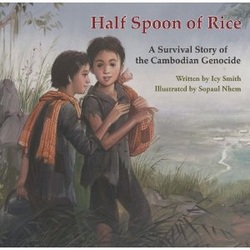
Half A Spoon of Rice: A Survival Story of the Cambodian Genocide
Written By: Icy Smith
Illustrated By: Sopaul Nhelm
Based on the stories of survivors, this stirring picture book for older readers tells of the Cambodian genocide in a present-tense narrative from the viewpoint of Nat, nine, who is driven from his city home by the Khmer Rouge in 1975, separated from his parents, and forced to labor in the fields.
Written By: Icy Smith
Illustrated By: Sopaul Nhelm
Based on the stories of survivors, this stirring picture book for older readers tells of the Cambodian genocide in a present-tense narrative from the viewpoint of Nat, nine, who is driven from his city home by the Khmer Rouge in 1975, separated from his parents, and forced to labor in the fields.
A Song for Cambodia by Michelle Lord
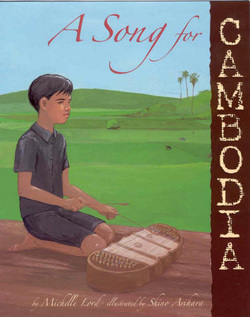
A Song For Cambodia
Written By:Michelle Lord
Illustrated By: Shino AriharaWhen Arn was a young boy in Cambodia, his days were filled with love, laughter, and the sweet sounds of music. That all changed suddenly in 1975 when Arn's village was invaded by Khmer Rouge soldiers and his family was torn apart.
Nine-year-old Arn was taken to a children's work camp, where he labored long hours in the rice fields under the glaring eyes of threatening soldiers. Overworked, underfed, and in constant fear for his life, Arn had to find a way to survive. When guards asked for volunteers to play music one day, Arn bravely raised his hand-taking a chance that would change the course of his life.
Written By:Michelle Lord
Illustrated By: Shino AriharaWhen Arn was a young boy in Cambodia, his days were filled with love, laughter, and the sweet sounds of music. That all changed suddenly in 1975 when Arn's village was invaded by Khmer Rouge soldiers and his family was torn apart.
Nine-year-old Arn was taken to a children's work camp, where he labored long hours in the rice fields under the glaring eyes of threatening soldiers. Overworked, underfed, and in constant fear for his life, Arn had to find a way to survive. When guards asked for volunteers to play music one day, Arn bravely raised his hand-taking a chance that would change the course of his life.
NEVER by Patricia McCormick
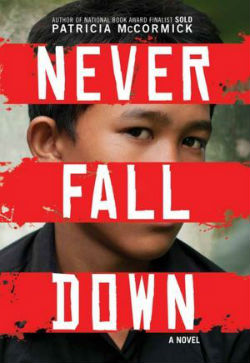
Never Fall Down
Written By: Patricia McCormick
Based on the true story of an 11-year-old boy who survived the Killing Fields of Cambodia by playing music for the Khmer Rouge. He would later find out that the music was used to cover up the sounds of the killings; as a man, he has worked to revitalize the traditional songs of Cambodia, an art form that would otherwise have been lost in the genocide.
Written By: Patricia McCormick
Based on the true story of an 11-year-old boy who survived the Killing Fields of Cambodia by playing music for the Khmer Rouge. He would later find out that the music was used to cover up the sounds of the killings; as a man, he has worked to revitalize the traditional songs of Cambodia, an art form that would otherwise have been lost in the genocide.
Sources
-Synopsis for books taken from Amazon.-http://en.wikipedia.org/wiki/Norodom_Sihanouk
Gemza, S. (2011). Survivor Stories. Retrieved from Cambodia: Genocide:
http://cybercambodia.com/dachs/stories/soy.html
Haddon, L. (2008, November 14). Socberty. Retrieved from The Use of Children in the Cambodian Genocide:
http://socyberty.com/history/the-use-of-children-in-the-cambodian-genocide/
HSM. (2012, September 20). Holocaust Museum Houston. Retrieved from Genocide in Cambodia (1975-1979):
http://www.hmh.org/ed_Genocide_Cambodia.shtml
"Khmer Rouge". Encyclopædia Britannica. Encyclopædia Britannica Online.
Encyclopædia Britannica Inc., 2012. Web. 17 Sep. 2012
<http://www.britannica.com/EBchecked/topic/316738/Khmer-Rouge>.
"Lon Nol". Encyclopædia Britannica. Encyclopædia Britannica Online.
Encyclopædia Britannica Inc., 2012. Web. 17 Sep. 2012
<http://www.britannica.com/EBchecked/topic/346805/Lon-Nol>.
News, B. (2012, September 6). Cambodia profile. Retrieved from BBC News, Asia-Pacific:
http://www.bbc.co.uk/news/world-asia-pacific-13006828
"Norodom Sihanouk." Wikipedia. Wikimedia Foundation, 21 Sept. 2012. Web. 17 Sept. 2012. <http://en.wikipedia.org/wiki/Norodom_Sihanouk>.
Place, T. H. (1999). The History Place. Retrieved from Genocide in the 20th Century:
http://www.historyplace.com/worldhistory/genocide/pol-pot.htm
"Pol Pot". Encyclopædia Britannica. Encyclopædia Britannica Online.
Encyclopædia Britannica Inc., 2012. Web. 17 Sep. 2012
<http://www.britannica.com/EBchecked/topic/466663/Pol-Pot>.
"Viet Cong (VC)". Encyclopædia Britannica. Encyclopædia Britannica Online.
Encyclopædia Britannica Inc., 2012. Web. 17 Sep. 2012
<http://www.britannica.com/EBchecked/topic/628305/Viet-Cong-VC>.
Walker, L. (2012, September 20). World Without Genocide. Retrieved from Cambodian Genocide:
http://worldwithoutgenocide.org/past-genocides/cambodian-genocide
Warren, K. (2012, September 20). Cambodia Genocide: Never again? Retrieved from Cambodia:
http://www.potomacschool.org/faculty/okoth/GSII/Spring06web/camwebpage-final.htm
Gemza, S. (2011). Survivor Stories. Retrieved from Cambodia: Genocide:
http://cybercambodia.com/dachs/stories/soy.html
Haddon, L. (2008, November 14). Socberty. Retrieved from The Use of Children in the Cambodian Genocide:
http://socyberty.com/history/the-use-of-children-in-the-cambodian-genocide/
HSM. (2012, September 20). Holocaust Museum Houston. Retrieved from Genocide in Cambodia (1975-1979):
http://www.hmh.org/ed_Genocide_Cambodia.shtml
"Khmer Rouge". Encyclopædia Britannica. Encyclopædia Britannica Online.
Encyclopædia Britannica Inc., 2012. Web. 17 Sep. 2012
<http://www.britannica.com/EBchecked/topic/316738/Khmer-Rouge>.
"Lon Nol". Encyclopædia Britannica. Encyclopædia Britannica Online.
Encyclopædia Britannica Inc., 2012. Web. 17 Sep. 2012
<http://www.britannica.com/EBchecked/topic/346805/Lon-Nol>.
News, B. (2012, September 6). Cambodia profile. Retrieved from BBC News, Asia-Pacific:
http://www.bbc.co.uk/news/world-asia-pacific-13006828
"Norodom Sihanouk." Wikipedia. Wikimedia Foundation, 21 Sept. 2012. Web. 17 Sept. 2012. <http://en.wikipedia.org/wiki/Norodom_Sihanouk>.
Place, T. H. (1999). The History Place. Retrieved from Genocide in the 20th Century:
http://www.historyplace.com/worldhistory/genocide/pol-pot.htm
"Pol Pot". Encyclopædia Britannica. Encyclopædia Britannica Online.
Encyclopædia Britannica Inc., 2012. Web. 17 Sep. 2012
<http://www.britannica.com/EBchecked/topic/466663/Pol-Pot>.
"Viet Cong (VC)". Encyclopædia Britannica. Encyclopædia Britannica Online.
Encyclopædia Britannica Inc., 2012. Web. 17 Sep. 2012
<http://www.britannica.com/EBchecked/topic/628305/Viet-Cong-VC>.
Walker, L. (2012, September 20). World Without Genocide. Retrieved from Cambodian Genocide:
http://worldwithoutgenocide.org/past-genocides/cambodian-genocide
Warren, K. (2012, September 20). Cambodia Genocide: Never again? Retrieved from Cambodia:
http://www.potomacschool.org/faculty/okoth/GSII/Spring06web/camwebpage-final.htm
